10.1 Grafts and Wounds
Learning objectives
By the end of this lesson you will be able to:
- Explain why plants are grafted or budded and the techniques employed for specific uses.
- Describe how a graft union heals.
- Compare and contrast how a plant responds to wounding versus healing a graft union.
Grafting
Grafting is the art and science of connecting two pieces of living plant tissue together in such a manner that they will unite and subsequently grow and develop into one composite plant. The union of these two different plant materials via grafting creates a chimera, — two different plant genotypes growing together in the same plant. The roots of an apple tree in a commercial orchard, for instance, likely came from a plant with a genotype that induces dwarfing of the tree. The picture below shows the swelling of the graft union a few inches above the soil surface.
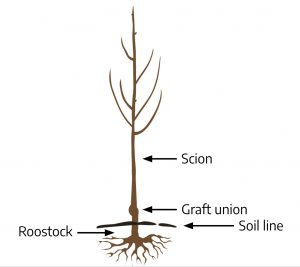
Grafting is means of asexual reproduction, which is vegetative propagation. The scions are exact genetic copies, and are sometimes called clones or clonal propagation. Although the graft can combine two different plant types, species, or even genera between the scion and rootstock, the scion material being propagated is an exact genetic copy of the parent plant that donates the vegetative parts used in the graft. Usually the scion or bud and rootstock are the same species, because this favors compatibility and successful grafting. The rootstock can thus be from mixed types, but the scion is from the same plant type for clonal propagation.
The shoot of a grafted apple tree, for example, comes from a plant with great-tasting apples, while the rootstock may not produce great apples. The root and shoot were grafted together and the tree grows as one plant, but with two genotypes: the roots have one genotype — one set of genes — and the shoot another, yet they are all growing as one plant. That’s a chimera.
When a horticulturist makes a graft, as in the apple trees above, one genotype of the tree species is typically used for the above-ground part of the plant, called the scion, and another for the below-ground portion, called the rootstock. A grafted plant has a scion growing on a rootstock, and the scion and rootstocks have different genotypes. In many grafting situations the scion and rootstock are of similar diameter, uniting the two genotypes where the graft union is made.
Grafting is a very old horticultural technique; there are historic records of horticulturists grafting olives 2,000 years ago. They may not have known how the cells divided and healed, but they knew how and why to graft.
Reasons to graft
While grafting is a valuable vegetative propagation technique, not all plants are easily grafted. For those that do respond well to grafting, there are different reasons for employing the technique.
Create unique, commercially desirable ornamentals
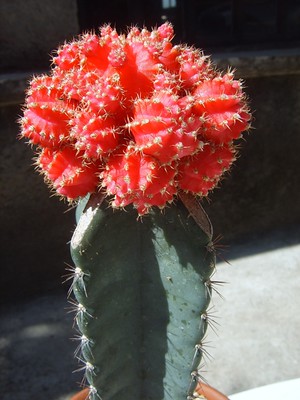
For photosynthesis to take place, a cacti growing as yellow or orange cannot live without the rootstock. Cactus propagation is commonly done by grafting; the cambiums are aligned, and the two are held together, often by rubber bands. This is often referred to as a modified method of cleft grafting.
Perpetuate genotypes that do not root from cuttings

Japanese maples, above, have highly desirable leaf and plant forms. Genotypes don’t root successfully from cuttings, but can be grafted onto a rootstock grown from seeds of less desirable types. The seedlings provide great rootstocks, and the shoot that has been grafted onto this rootstock expresses the highly desirable plant type. In this process horticulturists usually use T-budding, addressed later in the course.
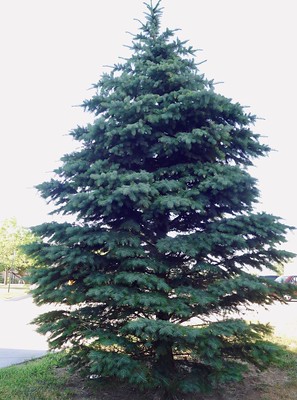
Conifers: Colorado blue spruce cuttings don’t root easily either, but blue spruce scions can be grafted onto Norway spruce rootstocks grown from seed to form a strong plant with the highly desirable blue spruce color and form.
Change cultivars
Most fruit trees, including apple trees, can survive for many years. In commercial apple orchards, some trees might be of cultivars that are no longer popular. Instead of pulling out these trees and planting young trees of a new cultivar, which difficult and expensive, new scions can be grafted from popular cultivars onto older trees after cutting those trees back to stumps. This is called cleft grafting or, more commonly, “topworking.” By putting the new scion on an established rootstock, an orchard will come back into production much sooner than if new, young trees were planted.
Produce trees with specialized forms
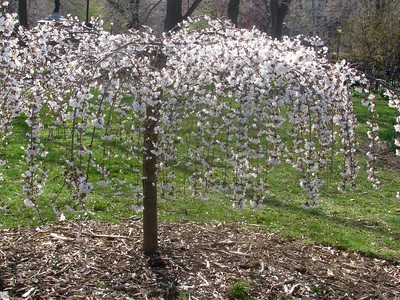
In the case of some flowering trees, like cherry and dogwood, propagators graft a weeping-type scion (one that looks like an umbrella rather than growing upright) onto a 3′ to 5′ standard rootstock. The “weeping” form has branches that arch downward rather than upright. The graft union is far above the ground rather than down by the soil, as is typically the case with grafted maple, spruce, and fruit trees. These weeping-habit trees are more prone to poor wound healing and regrowth of the rootstock at the point of the graft union.
Repair damaged plants
The idea here is to create a graft that re-unites the cambium in the tree trunk after being severed by a chewing rodent or mechanical damage such as might be dished out by an indiscriminately piloted weed whipper. The graft is inserted into a point below the damage and runs to a point above the damage. This grafting operation is particularly important when the tree is girdled or nearly girdled (the cambium is damaged all the way around the trunk) because otherwise the tree will die. This technique is called bridge grafting and can be quite successful in saving a tree. The picture is from Maple Valley Orchards where they bridged grafted several trees to save them from dying. You can see how the cambium and phloem have both been disrupted.
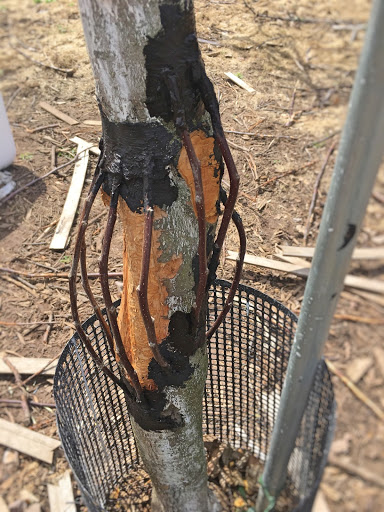
Take advantage of rootstock characteristics
All fruit trees grown in Minnesota are grafted, primarily in order to make the trees shorter. In apples, there are numerous rootstocks to choose from. If you are interested in growing Honeycrisp apples, for instance, you can grow a tree that will be anywhere from 6 feet tall at maturity to 25 feet tall at maturity, depending on which rootstock you choose. Same cultivar, “Honeycrisp,” but a different root system.
In a home landscape, many of us can think of a place for a tree that might grow to 12 feet high, but not many of us have places to grow trees that will get to 25 feet. In commercial orchards, almost all the trees that have been planted in the last 30 years are on dwarfing rootstocks. These trees are far easier to harvest, prune, and maintain.
Some rootstocks offer improvements in disease and insect resistance, or environmental stress such as cold or drought tolerance.
Watch this video to see an example of grafted oak trees and a graft union (1:11)
Grafting challenges
There must be a good reason to graft, and no easier or cheaper way to produce the desired plant. For most plant material that is grafted commercially, such as apple or peach trees, there is no other way to preserve the desired scion cultivar.
Grafting is an art. People who have grafted a lot of plant material understand aspects of their plants that will increase success, such as choosing compatible genotypes and matching stem diameters. Experienced grafters also know the timing of growth stages to increase grafting success. For example, whip and tongue grafts are done when both the rootstock and scion are dormant. In contrast, t-budding is done in August when the bark is “slipping” and the buds themselves are newly formed.
So why don’t grafts heal and produce new plants? Some of the reasons include:
- The type of plant is not conducive to grafting. Dicots and gymnosperms both have cambium encircling the stems, so aligning is possible. Monocot stems have cambium scattered around the stem, so aligning cambia between two plants is basically impossible.
- While the same species are often compatible and a successful graft results, as the relatedness decreases between the scion and rootstock, for example with different genera, grafting success is significantly reduced.
- Time of year and growing season both make a difference in graft success. Grafting success is more likely when the cambium is actively growing, but leaf growth is minimal, because water loss is at a minimum.
- The environment under which the grafts are healing, including temperature and humidity, is important. Light is less important.
- Technique is VERY important. If there is poor cambial contact, the callus bridge does not form, no vascular tissue is produced, and the grafted plant does not grow.
While most reasons to graft relate to desirable characteristics of the scion, there are situations in which the rootstock genotype or characteristics are also important. For example, apple and grape rootstocks are critical for correct plant form and disease resistance. Outside of those and perhaps a few other exceptions, the point of grafting is to propagate the scion.
Again, because of the expertise, time, and expense required for grafting, grafting is used only if it’s not possible to propagate a plant by other easier and cheaper methods, like planting seeds or taking cuttings. If a plant roots easily, and doesn’t require special rootstock characteristics like dwarfing or resistance to diseases and insects, there is no need for a graft.
Types of grafting and budding
Techniques for grafting have different names and are based on the type of plant material available and its stage of growth. Here are a few of the grafting or budding methods and when they are used.
Bridge grafting
Bridge grafting is used to repair damage to tree trunks. Smaller-size woody branches are used to reconnect the vascular tissues in the trunk so that water can flow up the trunk and sugars can flow down. These branches are the conduits.
Whip and tongue grafting
Watch this short video for a demonstration of whip and tongue grafting (3:57)
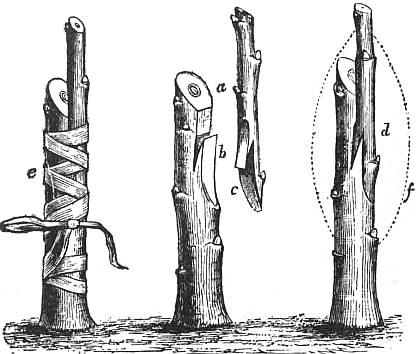
The whip and tongue graft is used when the rootstock and scion are the same size. If you have two pieces of woody plant material that are the same size in diameter, it is fairly easy to line up the cambium of each piece and slip the two pieces together. The video linked above shows the steps of this type of grafting, including the cuts that need to be made, how to tie the two pieces together, and the finishing step of reducing water loss at the graft union by applying a wax. For additional pictures and an explanation of the entire method, Texas A&M has an excellent short article with more information.
Approach graft
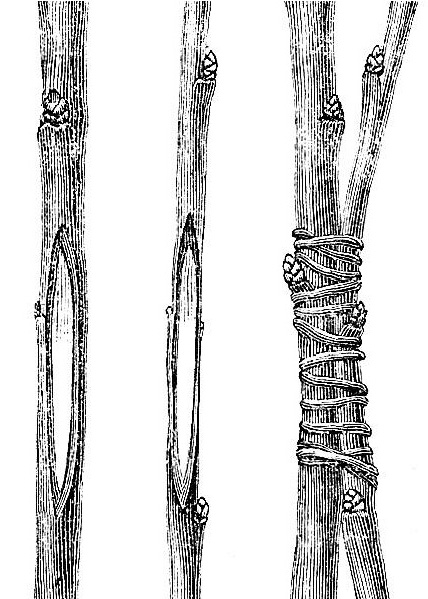
In approach grafting, the scion is often smaller than the rootstock. As the name indicates, the two plant materials are brought close together, the cambiums of both are aligned, and they are allowed to grow together. Often, in plant propagation, we have done approach grafting by using potato as the rootstock and tomato as the scion (remember that these two plants are closely related). Using the same methodology described above, the tomato and potato plants are potted into the same pot, a thin slice is taken off each stem to reveal the cambium, and the stems are tied together. When the graft heals, the plant on the top will produce tomatoes, and the one on the bottom will produce potato tubers that can be harvested at the end of the season. For a bit more reading, and a few more pictures, see the Texas A&M article.
Cleft grafting
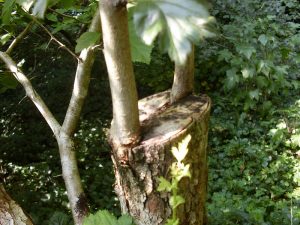
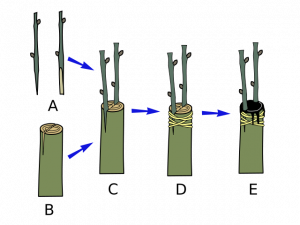
Cleft grafting is a technique which allows the union of a rootstock that is much larger in size than the scion. It is conducted in late winter, when both the rootstock and the scion are dormant. Common applications for cleft grafting include changing the variety of an existing orchard (also called topworking), adding a branch of an untested scion cultivar to an existing tree for observation, or repairing a tree that may have had a branch broken off by storm damage or fruit overloading. The technique can also be used for producing one tree with multiple cultivars on it. Have you ever read about an apple tree with 10 different types of apples on it? This is one method that can be used to make that happen.

T-budding
Watch this video to see how t-budding is done (3:57)
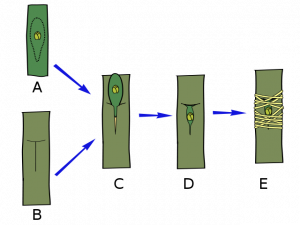
T-budding is done when bark is “slipping,” meaning the plant is actively growing. The technique is used frequently because it does not require as much plant material of the scion. This is particularly true with new plants, such as a new apple genotype, from which you want to propagate as many trees as possible. T-budding requires only one bud to make one tree, while whip and tongue grafting uses more buds per tree.
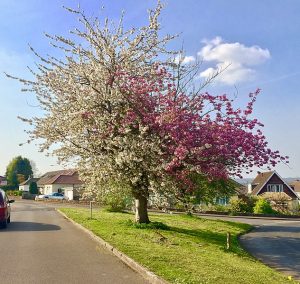
The grafting site at University of Missouri Extension is a great place to visit for more information.
Another interesting video highlights the work of a Syracuse art professor and his development of a single tree with 40 different types of plums, peaches, and apricots on it. What type of grafting did he practice?
Review questions
- How does grafting result in a chimera?
- What is the difference between grafting and budding? Why would you use one over the other?
- What types of plant habit can be produced through grafting onto special rootstock? Why are these habits desirable?
- Provide three good reasons to use grafting and three reasons not to use it.
- Provide two reasons why grafts are not successful.
- What type of grafting is recommended to repair trunk damage?
Wound healing
Watch this video to see how pruning wounds heal on trees (1:19)
What happens when you graft?
First, recall what happens when you do a stem cutting:
- The cells along the cut surface are sliced open, die, and become necrotic (dead) tissue.
- The surviving cells one layer in from the cut (parenchyma cells in the cortex) respond to the wound. There are two responses:
- The cells rapidly exude compounds like suberin (gummy substance) to protect the plant from excess water loss and invasion by diseases and insects.
- The cells are stimulated to divide and produce a mass of new cells to cover and protect the wound. The mass of new cells is called callus. This response takes quite a bit more time (like years) compared to the time required to exude suberin (hours).
From the plant’s point of view, the slicing that happens when making a graft is similar to the slicing that happens when you make an incision in the stem for a cutting. You are still slicing open cells, but because the rootstock and scion are in close contact, the environment around the cut ends is quite different from a cutting in which the wound is exposed to the environment. With a graft you have two stems that are held in close proximity and therefore are more protected than the open wound of a cutting.
- Within a few days, cell division starts and a callus of undifferentiated cells forms. The callus cells will continue to differentiate by developing cells with specialized form and function maturation of new cambium, xylem and phloem.
- The callus originates from parenchyma cells in the cortex, pith, or vascular bundles. The origin depends on the species.
- The callus grows from both the scion and rootstock.
- Callus from the rootstock and scion grow together to form a callus bridge.
- The parenchyma cells in the callus bridge that lie between the cambium of the rootstock and the scion differentiate into cambium cells.
- Additional parenchyma cells on either side of the cambium may differentiate into xylem and phloem until a connection among xylem, cambium, and phloem has been formed across the callus bridge.
- Once these links are formed, the cambium begins to initiate new xylem and phloem.
- Differentiation of the xylem and phloem is faster where cambium layers are closely aligned.
Again, it is important when grafting to get good cambium-to-cambium alignment between scion and rootstock. This will promote development of cambium cells that will differentiate into the callus bridge. The callus bridge is what joins the scion and rootstock. If your technique has poor cambial alignment, or gaps between scion and rootstock at the graft junction, the cell-to-cell linkage will not happen, or it will only happen weakly, and the graft will fail because there is no new xylem and phloem production, and therefore no water or sugar transport pathways. In addition to this being a linkage of plumbing so that water and sugars flow, it is also a structural linkage that gives the plant strength and rigidity across the graft union.

Five requirements for making a successful graft
- The rootstock and scion must be compatible. Even if they are from the same species, some scions won’t graft on to some rootstocks.
- The cambial layers of the rootstock and scion must be closely aligned and in contact.
- The graft must be done at the appropriate time of year. The buds, whether grafting whole stems or just the buds themselves, must be dormant. In temperate latitudes, grafting is typically done in winter when rootstock is also dormant, but budding is done late in the growing season when buds are formed, but dormant, and the bark is “slipping” so that a T-shaped cut in the bark can be opened into a pocket for the bud (image on the right).
- Grafts must be protected from drying.
- The grafted plant must receive proper post-graft care such as removing sprouts and suckers that emerge from the rootstock and might be mistaken for scion, and pruning or training the scion so that it develops the appropriate plant form.
Review questions
- Shortly after a plant is wounded, what is the first response of the surviving plant cells adjacent to the wound?
- When a wound heals, what cells are stimulated to divide?
- What types of tissues must be formed from the parenchyma callus if the graft is to be successful?
- How does the stage of plant growth differ for budding compared to whip-and-tongue grafting?
Art and science of connecting two pieces of living plant tissue together in such a manner that they will unite and subsequently grow and develop into one composite plant.
When two different genotypes are growing on a single plant.
Genetic composition of an organism.
Location where the rootstock and scion meet.
Portion of a graft that contains the shoot system and all above-ground parts.
Portion of a graft that contains the root system.
A form of grafting where the rootstock is much larger than the scion; both are dormant.
A type of budding performed using dormant scion buds on actively growing rootstocks; typically done in late summer outdoors.
A type of grafting performed on established orchard trees.
A type of repair graft used when a plant has been girdled; scion pieces are inserted above and below the girdled site and act to repair the disruption of the cambium.
A type of graft where both scion and rootstock are dormant and the same diameter; it is much more secure than other types of bench grafts.
Parenchyma cells that lie between the cambium of the rootstock and the scion and differentiate into cambium cells.
It is a form of grafting where a single scion is used rather than an entire stem.
A type of grafting where two independent plants are grafted together and severed only once the graft has "taken."
Swollen, underground, modified stems that store food.
Impermeable (to water and gases), waxy substance present in the cell walls of corky tissues.
A growing mass of unorganized parenchyma cells produced in response to wounding.
Process by which cells or tissues undergo a change toward a more specialized form or function.
Cutting away dead, overgrown, or unwanted branches or stems to improve safety, aesthetics, or productivity.

